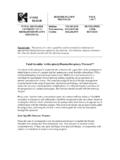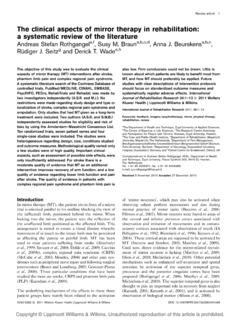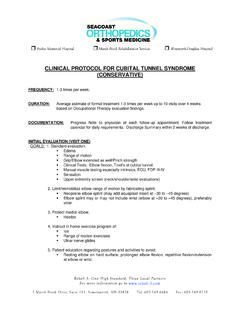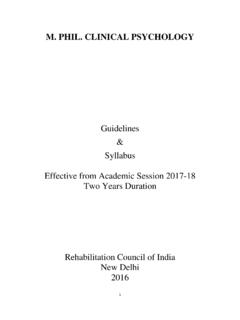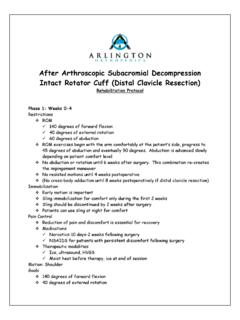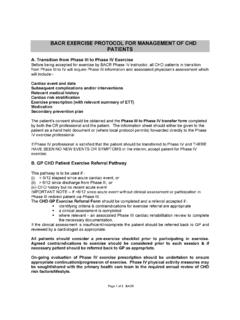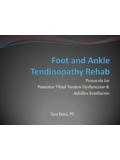Transcription of Clinical Guidelines for CPM following Rotator Cuff Repair ...
1 Clinical Guidelines for CPM following Rotator cuff Repair : synchronized or isolated protocol The primary goal of post-surgical rehabilitation following Rotator cuff Repair is to control pain, protect repaired tissue during the healing process, restore function, improve range-of-motion, restore strength and prevent a recurrence of During the initial healing phase following surgery, six weeks of passive range of motion is performed to protect the surgical ,17,18,23,25,26,28 Active and active-assisted exercise that result in a muscle contraction are not performed during the initial healing stage in order to protect the integrity of the Repair . The amount of protection that is needed for healing is determined by the size or quality of the tear and the type of procedure used for the Repair . Protecting tissue does not mean avoiding motion. Passive range of motion is utilized to prevent adhesions, prevent the detrimental effects of immobilization, reduce pain, reduce edema, reduce inflammation and stimulate soft tissue ,3,5,9,12,15,16,18,19,25,26 For a growing number of surgeons continuous passive motion (CPM) has become the Gold Standard for passive motion therapy during this six week ,9,12,15,16,28 CPM has demonstrated enhanced tendon healing that is statistically superior to intermittent motion and counters the harmful effects of ,7,13,29.
2 Passive Motion Analysis via EMG Studies CPM is a true passive motion modality with muscle activity consistently below 5%8. Over-head pulley exercise, bar raise exercise, and physical therapist assisted exercise can have muscle contractions over 25% secondary to postoperative pain and ,21 In contrast to these other exercises, CPM significantly (p= ). reduces postoperative Pulley exercises and bar raises are active-assistive exercise and more appropriate for phase two of the rehabilitation program. Rotator cuff Strain Analysis During Scapular Elevation and Rotation Arm position during passive exercise can also apply tension that is significant enough to result in a failure of the ,31 A Tension Free Zone has been determined for passive range of motion exercises following Rotator cuff ,31 This zone consists of scapular elevation/abduction performed above 30 and external rotation up to 60 in a scapular.
3 30 The Kinex Rotator cuff CPM performs passive motion precisely in this plane. Over-head pulley exercise, bar raise exercise and pendulum exercise are routinely performed outside of this Tension Free Zone increasing the chances of a poor result or failure. Home Exercise Compliance Analysis Patient directed exercises (over-head-pulley, bar raise, pendulum) have been prescribed as an alternative for passive exercise performed at home. However, follow through of these exercises have been sporadic at best with reports of 30-60% of Several authors have reported that patient directed exercises are difficult to perform and are painful, which may in part explain the poor compliance associated with these ,8 Typically, the number of physical therapy clinic visits will increase to compensate for poor follow through of home exercise programs. In contrast, CPM compliance is reported at 90%-122%.19,27,28 The high compliance reported for home CPM may be due to the pain reducing properties associated with CPM.
4 CPM Outcome Studies Passive motion by a CPM device has been compared to passive motion by a physical therapist, passive motion by a trained third party, passive motion by patient self-directed home exercise and immobilization. CPM. functional results are statistically equivalent or superior to physical therapy, manual passive motion by a third party, patient self-directed exercise or ,9,12,1525,28 CPM is statistically superior in range-of- motion and pain outcome ,25 Finally, CPM is more cost effective (saving 37% or $990 per patient). than passive motion provided by a physical Rotator cuff Repair with and without Subacromial Decompression Distal Clavicle Excision 1. Set-up Guidelines The patient is fitted and instructed on use of the Kinex The Kinex Shoulder CPM Device is Shoulder CPM Device preoperatively if possible to positioned in the Tension Free Zone . improve compliance. Passive glenohumeral joint motion in a non- Repeatable Anatomical Position: Kinex Head impingement and protective ,31.
5 Positioner is aligned to the patient to ensure . correct positioning each time the Kinex CPM. device is used. Helps avoid Repair stress. 35 -45 . Shoulder elevation is performed in the scapular ,18,31. Scapular elevation is 30 or above Anatomical Shoulder Alignment: Kinex Multi- (Kinex device will not go below plane Adjustable Arm helps ensure the CPM 30) .14,18,31. device is aligned with the shoulder throughout the External rotation is 0 -60 .14,.31. arc-of-motion. Helps avoid stress on the Repair . Postsurgical Grade Computer Sensor: Kinex CPM Device is only used in a pain free arc extra-sensitive sensor will reverse direction of of motion to protect the movement if too much strain is detected; set Initial Range of Motion between levels 15 (light) & 25 (heavy) depending on extremity size. Helps avoid stress on the Scapular Elevation 30 -50 arc Repair . External Rotation 0 -10 arc CPM use is initiated 24-48 hours Note: Initial arc of motion will vary from patient ,18,19,24,25 to patient depending on the size of the tear and type of Repair .
6 Provide patient instruction and demonstration in the use of the device. Supervise patient understanding on use for ROM adjustments and machine on/off function. protocol Option: 2. Wearing Schedule A. synchronized CPM: The CPM device is used for 6 ,25,28. Scapular elevation is synchronized with external The CPM device is used 3-6 hours a rotation (Kinex Shoulder CPM synchronized Mode performs elevation and external rotation Daily use guideline is 3-4 times a day for 1 or simultaneously in a safe arc). more hour intervals. synchronized CPM Set-Up Increasing Range of Motion Arc ( synchronized Scapular Elevation & External Rotation). Scapular elevation is increased in a 2:1 ratio over external rotation. Scapular elevation is increased 2 -10 a day as tolerated in a pain free arc. External rotation is increased 1 -5 a day as tolerated in a pain free arc. 0-2 Weeks 3-4 Weeks 5-6 Weeks 30-90 SE 30-120 SE 30-14 0 SE Examples: 0-20 ER 0-4 0 ER 0-6 0 ER SE: 2 5 10.
7 ER: 1 2 5 . SE= Scapular Elevation ER= External Rotation 3. End-Range Goals Scapular elevation end range goal is 140 -160 . OR External rotation end range goal is 40 -60 . B. isolated CPM: synchronized CPM: Scapular elevation is Scapular elevation is not synchronized with external synchronized with external rotation (Kinex rotation (Kinex Shoulder CPM ISO Mode performs Shoulder CPM synchronized Mode performs elevation separately from external rotation [10:10 scapular elevation and external rotation ratio]; elevation is performed with external rotation at simultaneously in a safe arc). 20 -30 and external rotation is performed with Modified from Dockery et al Supra- elevation at 30 ). Scapular elevation/abduction is set spinatus at 0% and external rotation is set at 75% or 100%. 25. Infra- spinatus Deltoid 20. isolated CPM Set-Up Trap- (Separate External Rotation & Scapular Elevation) % of Maximal 15 ezius Muscle Activity 10.
8 5. 0-2 Weeks 0. 30-90 SE CPM PT assisted Pulley Bar Raises 0-20 ER. Muscle contraction in healthy shoulders by exercise type. Post- operative shoulders typically have higher contractions than 3-4 Weeks depicted in the graph secondary to post-operative pain and apprehension with the exception of CPM because pain is 30-120 SE diminished. 0-40 ER. 5-6 Weeks Ide Gartsman 30-140 SE Royer LaStayo 0-60 ER Raab El-Zahaar Boehm SE = Scapular Elevation ER = External Rotation Peer-Reviewed Studies Evaluating Outcome Measures for the Efficacy of CPM following Rotator cuff Repair Clinical Study Self-Assessment Score Range-of-Motion Pain Primary Finding Evaluation and Cost Analysis Both the CPM and PT only group At one week flexion, abduction & Pain was not measured during This postoperative protocol using CPM. in Use of Continuous Passive showed improvements in their internal rotation were all the first several weeks to instead of PT provides a statistically Motion After Rotator cuff scores at 6 weeks and 12 weeks: statistically higher in the CPM evaluate differences in equivalent result to those protocols that Tears, A Prospective, CPM ( (pre-op), (6 weeks), group.)
9 At the 6 and 12 week discomfort during the time of utilize PT. Given this result the case of CPM. Randomized, Comparative (12 weeks); PT only (pre- intervals both groups were maximal pain. Both groups option is the more cost effective option. Both Study; Royer et al (2000, op), (6 weeks) (12 weeks). statistically similar in their demonstrated significant clinically effective protocols were compared. Institutional Review Board at Statistical improvement for both improvements (p=.05). Utilized reductions in pain at 6 and 12 CPM cost significantly less then PT cost over Henry Ford Hospital) groups with no statistical difference Index of Shoulder and Elbow weeks. the 6 week PROM only period. Savings of (p=.89). Surgeons. $990 per case was realized. Continuous Passive Motion Both the CPM and manual PROM Both options revealed statistically The CPM group had a CPM was statistically equal to manual after Repair of the Rotator cuff , exercises by a 3rd party were significant improvements in statistically significant passive range of motion in all outcome A Prospective Outcome Study; significantly successful pos-top motion (p=.)
10 853). reduction in pain compared to measures with the exception of pain Lastayo et al (1998, Journal of Rotator cuff Repair (p>.05). Scores the non-CPM group (p=.046). reduction. CPM was statistically superior for Bone and Joint Surgery) measured via the Shoulder Pain and reduction in pain compared to the manual Disability Index. group. Early Results of Continuous Both the CPM group and PT group A statistically significant A statistically significant The primary result of this study indicates that Passive Motion After cuff demonstrated statistically significant improvement was seen in the improvement in pain reduction both the CPM group and PT group improved Repair , A Prospective, overall shoulder score CPM group over the PT group was seen in the CPM group over the 3-month period after the Rotator cuff Randomized, Blinded, improvements at 12 weeks. (p=.0138). In fact the non-CPM for women p= and Repair .
